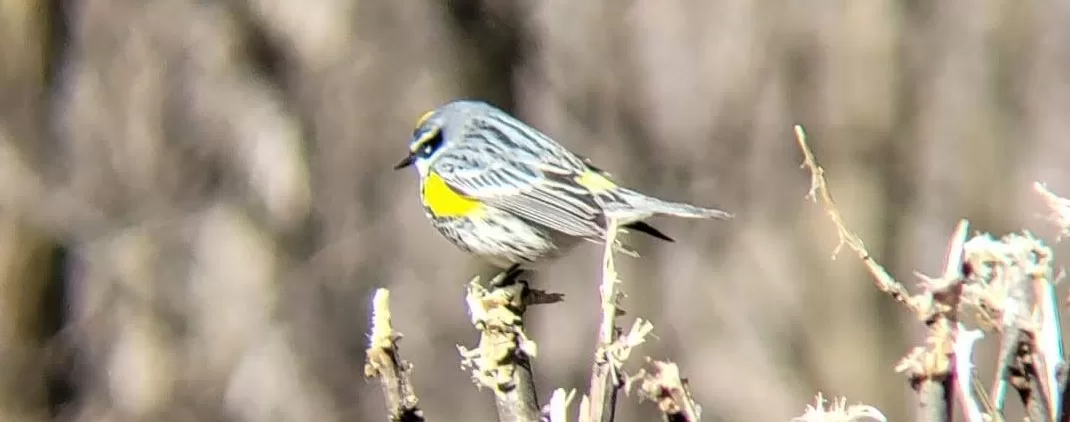Physical Characteristics
The Yellow-Rumped Warbler is recognized for its distinctive plumage and size. Key markings define its appearance, with noticeable differences between male and female birds, as well as seasonal changes in coloration.
Defining Markings
Yellow-Rumped Warblers exhibit striking colors that make them easily identifiable. The upperparts are generally gray to brown, while the underparts are white. The most prominent feature is the yellow patch located on the crown, sides, and base of the tail.
In breeding plumage, males display vibrant yellow swatches on the throat and sides that contrast sharply with darker wing markings. The wings feature two white wing bars that are noticeable in flight, enhancing their identification in the field.
Sexual Dimorphism
There is a noticeable difference between male and female Yellow-Rumped Warblers. Males tend to showcase brighter and more vivid colors, particularly during the breeding season.
Females are generally more subdued, lacking the intense yellow hues of males. They are often characterized by softer grays and browns. The female’s plumage is designed for camouflage, aiding in nest protection and brood rearing.
Plumage Variations
Seasonal variations in plumage are significant for Yellow-Rumped Warblers. In summer, males are more vibrant, showcasing bright yellow and black colors. In contrast, winter plumage presents a duller appearance with more gray and brown.
During the transition from summer to winter, birds will lose their bright feathers and adopt a more understated look. This change helps the warblers blend into their surroundings during colder months when they migrate to more varied habitats.
Morphology
In terms of size, the Yellow-Rumped Warbler is medium-sized for a warbler, measuring around 5.5 to 6.3 inches in length. They have a relatively robust body, which aids in adaptation to diverse environments.
The wings are slightly pointed, which contributes to their agile flight patterns. The tail is forked and features white outer edges, making it easily recognizable. Their stout bill allows them to forage effectively for insects and berries, essential for their diet.
Habitat, Diet, and Behavior
The yellow-rumped warbler thrives in diverse environments that support its feeding habits and behavioral patterns. Understanding its habitat preferences, diet, and interactions provides insight into its ecological role.
Habitat Preferences
Yellow-rumped warblers prefer a mix of coniferous and deciduous forests, often found in areas with plenty of shrubs for cover. They are commonly spotted in regions with abundant pines and mixed woodlands. During migration, they frequent wetlands and open areas that provide food sources. In North America, their habitat stretches across Canada and extends into the eastern and western United States. These birds select environments conducive to foraging and nesting, especially during the breeding season when vegetation is lush.
Feeding Habits
The diet of the yellow-rumped warbler is varied and season-dependent. In spring and summer, they primarily consume insects such as aphids, caterpillars, and spiders, which are crucial for nestlings. As autumn approaches, this warbler adapts its diet to include berries and fruits, particularly wax myrtle berries. They forage by gleaning insects from tree bark and foliage and often catch flying insects in mid-air. This flexibility in diet allows them to thrive across different habitats and seasons.
Interactions and Conduct
Yellow-rumped warblers exhibit interesting behaviors, especially during breeding season. They are known for their active foraging habits, often moving swiftly through trees and shrubs. These warblers are generally solitary or found in small groups, especially during migration. They can be quite vocal, using a variety of songs and calls to communicate with one another. Their interactions with other species often include competition for food resources, but they also coexist peacefully in shared habitats. Adaptability plays a crucial role in their behavior, helping them respond effectively to changing environments and food availability.
Migration and Conservation
Migration is a critical phase in the life of the Yellow-Rumped Warbler, influencing its population dynamics and conservation status. This species exhibits distinct migration patterns and routes, with specific population trends impacted by environmental factors.
Migration Patterns and Routes
The Yellow-Rumped Warbler migrates between its breeding grounds and wintering areas with remarkable precision. Breeding occurs from Northwest Alaska to Newfoundland, while wintering takes place primarily in Central America and along the southern U.S. coast.
Migration generally begins in late August to early September. Males typically leave earlier than females, facilitating a staggered arrival in winter habitats. Their journey can cover over 3,000 miles, and they often travel in flocks, which enhances safety during migration.
Population Trends
Current population trends for the Yellow-Rumped Warbler indicate a stable but cautious status. Studies show fluctuations due to changing environmental conditions. Factors like habitat loss and climate change can directly impact their breeding success, particularly in northern regions.
Monitoring programs assess population health, revealing that the warbler’s adaptable nature allows it to adjust to some habitat alterations. However, specific threats persist, such as widespread deforestation and pesticide use, impacting food availability during critical migration periods.
Environmental Impact
Environmental conditions greatly affect the Yellow-Rumped Warbler’s survival during migration. The impacts of climate change, like shifting weather patterns and altered food availability, can disrupt their established migration routes.
Conservation efforts aim to protect critical habitats, especially stopover sites. Preserving wetlands and forests aids in sustaining food sources and nesting areas. Moreover, community initiatives focused on reducing pesticide use can foster healthier habitats for these warblers and mitigate the risks they face while migrating.
Share this content:

Post Comment
You must be logged in to post a comment.